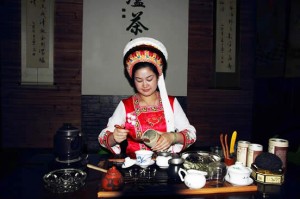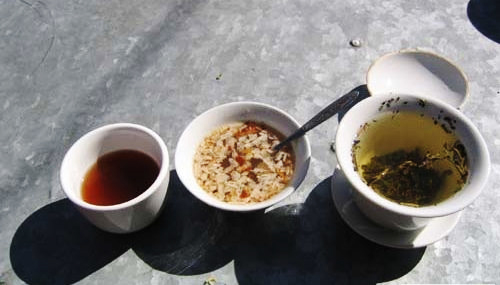The Bai people are renowned throughout China for their generosity and the warm-hearted welcome they give to all guests. The San Dao Cha or Three Courses of Tea ceremony is perhaps the finest example of their inherent hospitality. In Mandarin Chinese, the ceremony is often described as “the first is bitter, the second is sweet, and the third brings reflection” (一苦二甜三回味). It’s unsurprising then that the first course of tea is bitter, the second is sweet, and the third is a mixture of flavours with a strong aftertaste.
The first course begins by baking bitter tea leaves in a clay pot over a small open flame, shaking the leaves often so they do not burn. When the leaves turn slightly brown and diffuse a distinct aroma, then boiled water is added to the pot. As the water is added, it creates such a loud sound that this course is commonly referred to as “Lei Xiang Cha” (雷响茶) or “Thunderous Tea”. The water bubbles violently on contact but, once it has stopped bubbling, the tea is ready to drink. This unique process produces a small amount of tea that is fragrant and incredibly concentrated. The thunderous tea is so bitter that it may just feel like a lightning strike to your tongue!
After all that bitterness, you’ll be thanking your lucky stars that the second course is a sweet tea! It is made by first adding a kind of cow’s milk cheese known as rushan to the tea cup, along with tea leaves, walnuts, brown sugar, and other ingredients depending on the region. Boiling water is then poured into the cup and the tea is offered to the guest. This tea resembles more of a soup but is tantalisingly sweet!
The third course is the most complex in terms of its ingredients, as it’s meant to be bitter, sweet and spicy all at the same time! This is achieved by mixing honey, Sichuan pepper, slices of ginger, and cassia (Chinese cinnamon) with a hot cop of Cangshan Xue green tea. The tea not only embodies all of the flavours of the previous courses, as well as being spicy, but also has a distinct aftertaste that has earned it the name “Hui Wei Cha” (回味茶) or “Reflection Tea”.
 The term “san dao” does not only mean “three courses” but also refers to the tea being poured three times. The first pouring is for the guest to smell the aromatic tea; the second is to sample the tea; and the third is for the guest to finally drink the tea.
The term “san dao” does not only mean “three courses” but also refers to the tea being poured three times. The first pouring is for the guest to smell the aromatic tea; the second is to sample the tea; and the third is for the guest to finally drink the tea.
The three types of tea used are designed to imitate the course of life; first you experience bitterness, then you feel happiness after overcoming hardship, and finally you rest and reflect on your past. A direct correlation is sometimes drawn between the stages of life, as a young person goes through much hardship, a middle-aged person feels the sweetness of achievement, and an elderly person recollects their experiences. Although we’ve only mentioned a few of the practices employed in this elegant ritual, there are actually a staggering 18 procedures in the ceremony that are all governed by strict etiquette!
